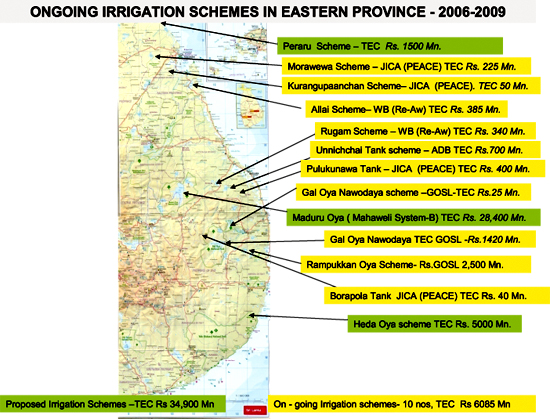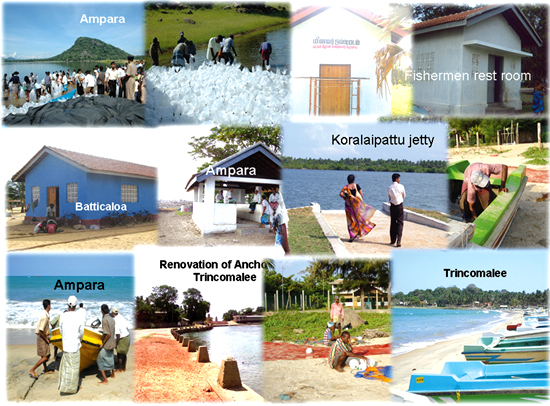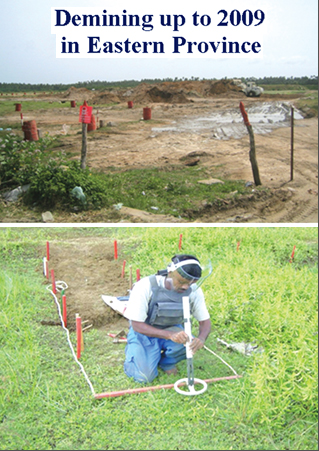|
Five years of development - Ampara, Batticaloa
districts:
Synergetic mechanism clicks with 'Eastern Revival'
by P. Krishnaswamy
 The Eastern districts of Ampara and Batticaloa were among the worst
affected regions in the three-decade long conflict and the 2004 Boxing
Day tsunami but life returned to normalcy, thanks to the far-reaching
development programs implemented over the past five years under the
Mahinda Chintana. The Eastern districts of Ampara and Batticaloa were among the worst
affected regions in the three-decade long conflict and the 2004 Boxing
Day tsunami but life returned to normalcy, thanks to the far-reaching
development programs implemented over the past five years under the
Mahinda Chintana.
The Negenahira Navodaya (Eastern Revival) is a crucial program that
incorporates the core components of the Mahinda Chintana. Under this
program measures were taken to restore civil administration, provision
of resource allocation among all communities, speedy implementation of
mine action program, recommencement of livelihood activities,
reconstruction of damaged social and economic infrastructure and
industrial development with private sector participation.
The resettlement of over 206,000 persons of the Eastern province, who
were displaced due to the conflict, was successfully completed after the
Northern and Eastern provinces were liberated from the clutches of LTTE
in May last year. Democracy was restored with the setting up of the
Eastern Provincial Council. The social and economic infrastructure was
revived after clearing all landmines at a cost of Rs. 120 billion under
the Negenahira Navodaya program. A large number of bridges in the East
including Kinniya, Sri Lanka's longest bridge, and the Arugam Bay bridge
were opened to the public at a cost of over Rs. 7 billion. Under the
Negenahira Navodaya program electricity was provided to 171,000 housing
units up to 2008 under the 665 electricity schemes at a cost of Rs.
1,534 million. In addition 276,000 people benefited under the water
supply scheme with an investment of Rs. 45 billion.
 The Oluvil Port Project in Ampara, one of the major projects was
accelerated under President Mahinda Rajapaksa's administration for the
economic development in the region. The total project at Stage I is Euro
46,095,369.49. The loan agreement was signed between the Ministry of
Finance and Planning and the Nordea Bank, Denmark on May 23, 2008. The
project will provide infrastructure for the economic growth of the
Eastern region. The port will form the Southern link in the developing
chain of the coastal harbours in the country and will provide more
convenient and cost effective access to and from the Southern region for
goods and cargo originating from the West coast. The Oluvil Port Project in Ampara, one of the major projects was
accelerated under President Mahinda Rajapaksa's administration for the
economic development in the region. The total project at Stage I is Euro
46,095,369.49. The loan agreement was signed between the Ministry of
Finance and Planning and the Nordea Bank, Denmark on May 23, 2008. The
project will provide infrastructure for the economic growth of the
Eastern region. The port will form the Southern link in the developing
chain of the coastal harbours in the country and will provide more
convenient and cost effective access to and from the Southern region for
goods and cargo originating from the West coast.
The project comprises the construction of a commercial harbour and a
basin for the fishing craft.It covers a land area of 60 ha under the
first stage and 105 ha under the second stage. The harbour basin would
cover an area of 16 ha of the sea and would spread 1.2km along the coast
line. Facilities under Stage I will include the harbour basin for 5,000
ton ships, Pilot Station, Prefabricated Warehouse, Administration
building and a Fishery Harbour with an ice plant, cold storage
facilities, fish auction halls and refrigerated storage. Work is now in
progress and Stage - I would be completed in September this year.
The Ministry of Nation Building has been mandated to implement the
Eastern Revival Program and projects including the Gama Neguma among
others, through a synergetic mechanism for the proper resource
allocation and coordination to ensure maximum benefit for the people of
the region.
 Rs. 111 billion, both from domestic funds and foreign finances, have
been utilised for resettlement, economic infrastructure, productive
sector and social infrastructure development under the Eastern Revival
program up to 2009. Rs. 111 billion, both from domestic funds and foreign finances, have
been utilised for resettlement, economic infrastructure, productive
sector and social infrastructure development under the Eastern Revival
program up to 2009.
In mapping out the implementation strategy of Eastern Revival, the
areas of specific development programs have been identified as an
effective way to meet the development needs and priorities for the
districts. The Eastern Revival is also connected with the National
Programs and Projects including mega infrastructure projects which are
aimed mainly at improving the connectivity with other regions. These
projects are expected to create new opportunities for investment with
expansion of employment opportunities in the region, particularly
private sector investment.
The main component of the Eastern Revival program includes in
inter-connectivity and other supportive infrastructure projects which
are aimed at improving mobility and accessibility at regional level.
These projects will also improve the capacity of the regions to link
with the mainstream development. The specific area of development
activities have a catalytic role in boosting commercial activities in
the districts of Ampara, Batticaloa and Trincomalee.
In the districts of Batticaloa and Ampara two major bridges - the
Oddamavadi Bridge and the Kallady Bridges - are being constructed at a
cost of Rs. 350 million and Rs. 400 million. The
Thirukoddigamadu-Akkarapattu highway and the Navalady-Trincomalee
highway are being renovated at a cost of Rs. 3,800 million and are due
to be completed soon, according to sources of the Government
secretariats. Concrete roads in rural areas are being constructed at a
cost of Rs. 800 million in the Batticaloa district. The Urugamam,
Navagiri and Pudugunawa irrigation tanks have been renovated at a cost
of Rs. 232 million and an additional land area of 10,000 ha has been
brought under paddy cultivation in the Batticaloa district.
 All roads ranging from A grade to C grade were renovated between
2006-2009 at a cost of Rs. 14,017.62 million. The Rambukkanoya, Mahaoya
Irrigation Projects costing Rs. 2,500 million was set up at a cost of Rs.
614.91 million in the years 2007-2009 for the project. Rs. 28,665
million was spent on the subsidised fertiliser project for farmers in
the Batticaloa district. All roads ranging from A grade to C grade were renovated between
2006-2009 at a cost of Rs. 14,017.62 million. The Rambukkanoya, Mahaoya
Irrigation Projects costing Rs. 2,500 million was set up at a cost of Rs.
614.91 million in the years 2007-2009 for the project. Rs. 28,665
million was spent on the subsidised fertiliser project for farmers in
the Batticaloa district.
All paddy lands that remained fallow for over two decades due to LTTE
terrorism in the province were brought under cultivation. Many
incentives for farmers, including free seed paddy, tractors for
ploughing and fertiliser at highly subsidised rates were provided. The
Eastern province is projected to produce over 35 percent of the
country's total paddy production, according to an Eastern PC Minister.
Plans are under way to double the paddy cultivation in the coming years,
he said. Paddy production has shown much progress after 2006 because of
easy accessibility to the fields and increased inputs for paddy
cultivation. But the climatic conditions that prevailed affected
production during Yala 2009. The total asweddumised area was 183,745 ha
during 2006. In both seasons (Yala and Maha) approximately 166,712 ha
were cultivated and the paddy production was 703,950 m.tons. In 2007
paddy cultivation was on 175,090 ha - an increase of 5 per cent in
acreage and the paddy production was 742,526 m.tons and the average
yield was 4.1 m.tons per ha.
The other components of the Eastern Revival program is livelihood
development program aiming at expanding livelihood opportunities and
improving the living conditions of households at grass roots level.
These activities focus mainly on the following areas, viz: Maga Neguma,
electricity, drinking water, irrigation and livelihood development. All
these activities are coordinated and carried out under the Gama Neguma
with the involvement of all stakeholders from the Eastern region through
Government Agents/Provincial Institutions/Statutory Bodies under the
coordination and resource allocation by the Ministry of Nation Building.
In this process the office of Basil Rajapaksa, MP, Senior Advisor to the
President provided guidance and reviewed the progress of all development
activities, including the 180-day Program for the Sun Rising Region of
Sri Lanka which was inaugurated by the President in mid-July 2007.
In the Batticaloa district Rs. 6,547,389.6 million was disbursed for
the coconut sector for re-planting, under-planting, re-planting, home
gardening, rehabilitation and gliricidia subsidy out of the total
earmarked Rs. 13,509,510 million. In the Ampara district Rs. 8,274,761
million was disbursed for the coconut sector. In the Ampara district Rs.
292,603.81 million was disbursed out of Rs. 365,010 million earmarked
for the rural industries (clay-based products -Maligatenna). In the
Ampara district Rs. 146.5 million was disbursed for the rehabilitation
of the Karawahu Drainage Scheme under the re-awakening project of the
total Rs. 240 million to be allocated. In the Batticaloa district Rs.
81.4 million was disbursed to rehabilitate the Rugam scheme under the
Re-awakening Project out of the total Rs. 340 million to be allocated.
|

